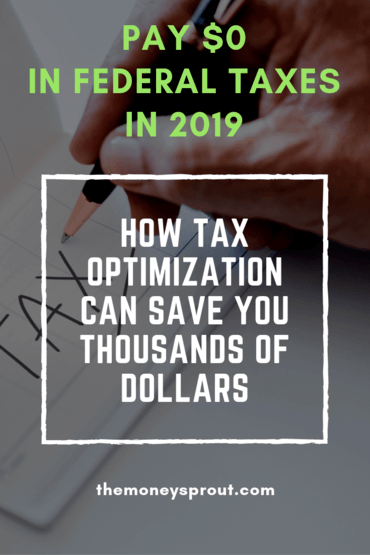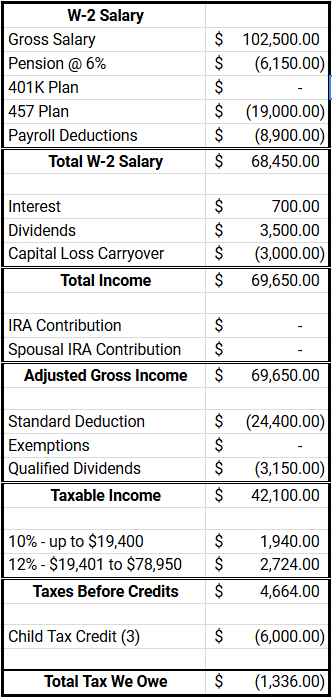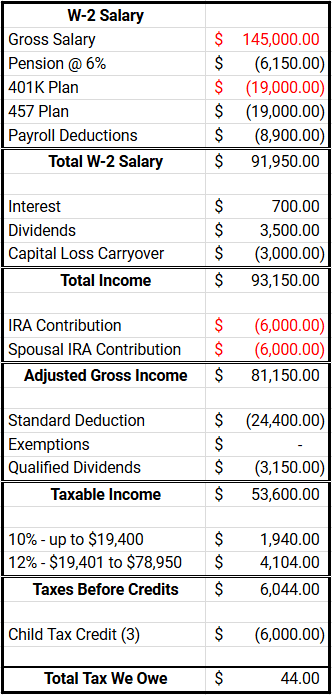This post may contain affiliate links. Please read our disclosure for more info.
This past year … one of the best ways our family was able to save money may surprise you. It wasn’t by cutting our cable … which we did years ago. And it wasn’t by selling our cars that cost us a bunch of money every month to drive.
Did we finally decide to downsize our home to save money? Nope … although we are really starting to consider this one.
Maybe we stopped eating out? Another activity we rarely do .. so we didn’t really save much in this area either.
We were able to save around $3,000 in 2018 by optimizing our taxes.
By following the current tax law and using the tools available to us … we were able to drive our federal tax bill down to $0 this past year.
I should point out that we haven’t filed our taxes yet, but it appears our federal tax obligation will be $0.
We took advantage of some tax breaks, retirement plans, and other tools to put several thousand dollars back in our pocket.
Our plans are to do the same in 2019.
In this article, I will show you our plans to lower our taxable income in 2019 to get under our FREE Money Number.

Tax Optimization Will Save Thousands of Dollars
For the purposes of this exercise, I modified a few of the salary and deduction amounts from our current situation to make the numbers easier to use. The numbers I have provided are very close to actual amounts (see figure #1).
Personally, I like to show examples in whole numbers … plus I want to have a little secrecy to my actual income.
Our current tax calculation for 2019 has our family of five (3 kids and 2 adults) owing no federal tax for the second straight year.
For comparison, in 2016 we paid around $2,900 and in 2017 we paid around $3,000.
While we haven’t filed our 2018 taxes at the time of this writing … we have calculated paying $0 in federal taxes in 2018. Our goal is to continue this trend in 2019 by leveraging several tools available to us under the current tax law.
Note – The exercise below only covers federal taxes. Our state taxes will be different and we will still have payroll taxes on our W2 income. Plus any side business income would need to be accounted for too.
So what tools are we using to get to a 0% tax rate?
How We Will Pay $0 Federal Taxes in 2019

Note – Before we get started, I wanted to point out our taxes are filed as – Married Filing Jointly.
I have adjusted our gross salary in 2019 to an even $102,500 of W2 income for this example. This is a slight increase in the estimated gross salary we ran in 2018 of $100,000. The year to year increase reflects a cost of living increase that was received last year.
Our income will actually be a bit higher than what we share here, but it is close enough for this example. We keep a separate spreadsheet with our actual real numbers … just to make sure we don’t miss anything.
Now that we have our total estimated salary for 2019, we need to find a way to reduce our taxable income. I certainly don’t want to pay taxes on over $100,000 of income!
The first thing we need to look at are the pretax payroll deductions that come out of my paycheck at work.
There are several payroll deductions that will help to quickly lower our taxable income next year.
Pretax Payroll Deductions
The first reduction to our taxable income will come from a mandatory pension deduction of 6%.
So right off the top, $6,150 comes out of our check and into our pension fund … reducing our taxable income.
This is a mandatory deduction … but a good one. Eventually, this pension will be part of our post financial independence income.
Next, I have a couple different options for work place retirement accounts – 457b and 401k.
Starting out in 2019, we plan to only use our established 457b account that was setup in 2017. Just like with our pension, anything that goes into this retirement bucket comes directly off our taxable income.
The annual limit has increased to $19,000 in 2019 and we plan to max it out. So that is another $19,000 that will come off our taxable income.
In the future, as our income grows (and we want to avoid paying federal taxes) we can open a 401k account at work too and double dip. That gives us room for another $19,000 off the top of our income. But for now … we will hold steady with just the 457b contributions.
The final pretax payroll deduction (to help lower our taxable income) is our workplace benefit plans. Medical, dental, vision, life insurance, etc. deductions take out another $8,900 of pretax dollars.
For now … our combined pretax payroll deductions will reduce our taxable income by $34,050 in 2019.
This lowers our taxable income automatically to $68,450.
Now that we have our taxable W2 income … we need to account for any additional income that we get from dividends and interest.
Dividends and Interest
We need to adjust our income to include any interest or dividends we expect to earn over the year.
For now, I am estimating about $3,500 in dividend income from stocks we own in our taxable accounts. We will likely earn around $4,500 in dividend income next year in our tax deferred accounts. So we won’t need to include that income.
As the year goes on, we can get a better understanding of how much dividend income we will earn for the year and optimize even further if need be.
The good news is that most of it (about 90%) is from qualified dividends … which are taxed like long term capital gains. Even better news is that if we can keep our income under $78,750 next year … our dividend income will be taxed at 0%!
In addition to dividend income … we can expect another $700 of income from interest. This is mostly interest we are earning on our emergency fund.
One last item we need to account for in this section are capital gains losses … or in our case carryovers from previous years.
The good news is that we will have another $3,000 capital gains loss from prior years to carryover in 2019!
So our net addition to our overall income (dividend income + interest – carryover capital gains loss) is $1,200 … which increases our taxable income to $69,650.
Another piece of good news that we will cover later is that we can take back dollars from qualified dividends … which is the majority of our dividend income anyways.
Now we will cover a few additional deductions available to us … outside of payroll deductions.
IRA Contributions
My wife and I both have the option to contribute up to $6,000 each in 2019 ($12,000 total) to an IRA. This is for either a Roth, Traditional, or combination of the two up to $6,000 combined per person.
If the money goes to a traditional IRA … then we can use those funds to reduce our taxable income even further.
If the money goes to a Roth IRA … then we cannot use those funds to reduce our taxable income this year. However … we won’t have to pay taxes on our gains in the future when we take it out.
For now, we don’t need to reduce our taxable income any further to pay $0 federal taxes … based on what we have shared above. So our plans are to fill up both our Roth IRA accounts for a combined total of $12,000. This let’s us optimize our taxes now and in the future.
However … as our income grows … this is another bucket to put money to help defer more of our income.
So if we need these buckets to reduce our taxable income we will certainly use them.
At this point, our taxable income remains at $69,650 … which is well below our 2019 FREE Money calculation of 77,633!
And we are still in the 0% capital gains tax bracket limit of $78,750 for income!
Deductions and Credits
Now the fun part starts … this is where our FREE Money can be used to drop our federal taxes to $0!
There is no doubt … we will be taking the standard deduction for married filing jointly of $24,400 for 2019.
Our mortgage interest, property taxes, and other charitable deductions won’t come close to this number. Taking the standard deduction will bring our taxable income down to $45,250.
We can also take back off approximately $3,150 of qualified dividend income … which puts us at $42,100. I am estimating our qualified dividend income at approximately 90% of our total.
So before any child tax credits, we will be taxed on $42,100 for 2019.
Next let’s look at the different tax brackets and how much we might owe … before any credits.
Federal Tax Brackets
For the new federal tax brackets in 2019, we only really care about the first 2 … since our taxable income is so low. We are close to the 22% bracket but should be fine staying under it with all the tools we have available to us to lower our income.
These are the 10% and 12% tax brackets for married filing jointly in 2019 –
- 10% – $0 to $19,400
- 12% – $19,401 to $78,950
This means our first $19,400 of income earned will be taxed at 10% or $1,940.
The remaining $22,700 of income we have leftover will be taxed at 12% or $2,724.
So without any child tax credits, we would owe $4,664 in federal taxes after making $102,500 in W2 income plus dividends and interest.
Child Tax Credits and $0 Taxes Owed
The good news for us, is that our 3 kids will give us a $6,000 credit in 2019.
So based on this credit, we won’t owe any federal tax because our tax liability is less ($4,664) than our available credits ($6,000). It actually gives us a lot of leeway to increase our income and still pay $0 in federal taxes for 2019.
And if our income goes crazy with side hustles or anything else … we still have our 401k bucket and possibly IRA contributions.
Estimated 2019 Federal Tax Liability = $0
If you haven’t built out your tax optimization calculations … I strongly encourage you to do so. I never paid much attention to our tax optimization prior to 2017 and regret it every day.
How Much More Income Can We Earn?

In order to reach financial independence sooner … I have been exploring opportunities to earn side income.
We have a couple possibilities which include – my wife working part time, me picking up some freelance work, earning blogging income, etc.
However, one of the issues with earning more income … is the perceived tax implications.
With a $100,000+ salary already, I am concerned that earning anything more from a side hustle wouldn’t be worth the tax hit.
The good news is … based on our tax optimization calculations I have been working with … I’ve calculated we could earn an additional $42,500 of income and would owe $44 in federal tax.
That seems to be a pretty good amount of extra income for such a little bit of tax.
Note – This calculation does not consider any state tax liability nor does it factor in any payroll taxes for social security which would need to be paid. And we would likely get hit with some additional capital gains taxes with some of our dividend income.
Paying $44 in federal taxes (plus any capital gains tax) on $145,000 doesn’t just happen on it’s own however. It takes a little strategy and planning. Otherwise, earning that kind of income would hit us with a big tax bill.
Optimize Your Taxes as Your Income Grows
Here are the additional steps we would have to take in order to maximize our income and optimize our taxes with an extra $42,500 of income.
- still max out 457b workplace plan at – $19,000 (we plan to do this already)
- open up and max out a new 401k plan – $19,000
- max out my traditional IRA contribution to $6,000
- max out spousal traditional IRA contribution to $6,000
For the most part … the remainder of our pretax deductions and exemptions would remain the same.
Note – These changes are all highlighted in red on figure #2.
One last item … since my pension is only tied to my full-time job, no additional savings would come out of that bucket to save us even more. However, if my salary were to rise by $42,500 … then there is more opportunity because 6% is deducted to my pension.
So there you have it … we can push our income by approximately $42,500 more dollars and only pay less than $50 of federal tax in 2019.
Know Your Tax Situation
This is all awesome news and gets me very excited. The only problem is that I can’t believe for the past 20+ years of my working career … I never paid much attention to tax optimization.
Even though the most recent tax law changes in 2018 have really helped our family keep more of our income … we still should have optimized our savings more in 2017 and before. We still could have saved thousands of dollars in taxes.
I’m sure in the the future there will be different tax law changes put into place. Our income situation will likely change. So what you see here today for our 2019 tax optimization will likely be different in 5 or 10 years.
So for now we are controlling what we know. Our goal is to keep our taxable income levels to the point where our federal tax bill is small.
And if there are situations that we can optimize for our future taxes (by using the Roth accounts), then that is even better.
Are you taking advantage of tax optimization to keep more of your income? What strategies are you using?